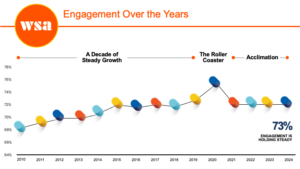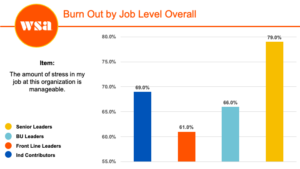In this installment of Kris’ Kolumn, we continue exploring evolving workforce dynamics. Today, we’ll dig into our analysis and discoveries from the WSA Monthly Learning Session, where we continue discussing insights from the 2024 State of the Workforce report. This is part two of a two-part series.
Reflecting on Engagement Stability and Shifts
Over the past 14 years, our engagement studies have shown a relatively stable trend pre-pandemic, with employees seeking inspiration and a clear sense of direction from their leaders. However, between January 2020 and December 2022, what we’ve termed the “roller coaster ride” changed
the workforce landscape as we know it. This era saw a peak in engagement levels followed by a sharp decline, unlike anything observed in the preceding years.
As 2023 rolled around, we expected to see a gradual return to pre-pandemic engagement trends. Instead, 2023 became what we call the “year of acclimation.” This phase is crucial for understanding new workforce expectations and the evolving needs at all organizational levels.

Key Engagement Drivers in a Post-Pandemic Workforce
Our latest data refresh, which includes responses from 2021 to 2023, lets us identify the top predictors of engagement, going beyond merely understanding key drivers to pinpoint actionable insights. Interestingly, engagement drivers have shifted from individual desires to a more holistic approach toward employee experience. Leadership at all levels now plays an integral role in the employee experience. Employees want three critical things from leaders:
- They want to be inspired by and trust their senior leadership
- They want to know they are important to the success of their teams and organization
- They want opportunities to learn and grow
Making Leadership Count at Every Level: The State of Leadership Today
Our April Learning Session highlighted leadership effectiveness across different management tiers, including senior leaders, middle managers (business unit leaders), and frontline leaders. The engagement scores among these groups vary significantly, identifying a potential disconnect between top leaders and other layers of the organization. In fact, there is a pretty big disparity, especially between senior leaders and business unit leaders. This is a speed bump for organizations because business unit leaders are not only the speaker to employees on future vision and business priorities but also the microphone back to senior leadership on what’s happening at ground level.
So, while engagement has normalized–we must note that we are seeing a worrisome gap within the leadership structure itself.
Concurrently, leadership effectiveness at the same leadership levels has leveled out. But if we break it apart level by level, we see a large gap between senior leaders and frontline and business unit leaders. This could risk that senior leaders are perceived as out of touch and is a sign that frontline and business unit leaders are more critical of their next level of leadership.
Engagement and Effectiveness Gap
The intersection of engagement and effectiveness shows us a meaningful difference between how people score the person they report to and their overall level of motivation, commitment, and conscientiousness about the organization. This is an indicator that people feel very “local” about “me, my team, my manager” and less connected to the organization overall.
This creates a risk of managers moving on or quitting and causing a feeling of “loss” for employees. To overcome this, organizations need to focus on empowering their front-line leaders to be good translators of the organization’s vision, identify growth opportunities, and show the value of the contributions of every individual on the team.
The State of Female Leaders
Over the years, we learned that women’s engagement and effectiveness in leadership caught up to their counterparts–the gap closed on each of these post-pandemic. But that landscape is now changing.
For frontline leaders, that gap remains closed, but as we climb the ladder the gap begins to grow again to show a disparity between women and men in business unit leaders and an even higher disparity between women and men in senior leadership.
An influencer of this is the overall level of burnout that is happening at the business unit and senior leadership level–it’s higher than it ever has been. Burnout and the lack of flexibility are pushing female senior leaders away and disengaging them from the workforce. In fact, according to outside research, 10.5% of women senior managers up to C-suite have quit their jobs, which is a 5-year high.
Organizations need to ensure that female leaders feel valued, have input and insight into personal and professional life, see a clear link between their work and the company’s success, and have the freedom to be flexible.

What Leadership Needs to Demonstrate
First, leaders need to inspire and direct their people so their team feels good about where they are going. Second, they need to empower their people to manage the work effectively and provide a sense of “air traffic control” to their teams. Third, they need to be present. Being present means actively listening, asking for input, recognizing extra efforts, and caring about employees on an individual level.
Learn more about how to implement each of these in the WSA Monthly Learning Session, State of the Workforce Trends, Part 2. It boils down to employees wanting an individualized approach from their leadership. Every leader in your organization should focus on ensuring every leader is a good coach, does what they say they are going to do, and makes it personal.
Strategic Insights for Moving Forward
The organizational focus should be on ensuring that all leaders, especially those at the mid and frontline levels, are equipped to translate strategic visions coming from the top into actionable goals for their teams. Fostering an environment in which leaders at all levels are actively involved in strategy formulation and day-to-day employee engagement is indispensable.
Leaders have never been more important as we continue to adapt to post-pandemic realities. Our ongoing analysis aims to equip organizational leaders with the insights needed to enhance engagement and effectiveness, ensuring that they are prepared to meet the evolving demands of the workforce.

